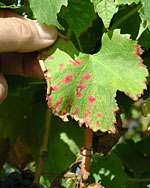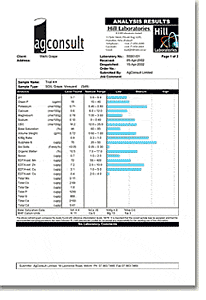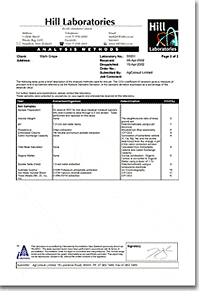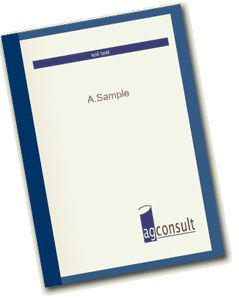|
|
TESTS AGCONSULT CURRENTLY OFFER

AgConsult offers
on-site Consultancy |
|
One of our main activities is interpretation of soil, petiole
and leaf test results. Although the test results of a wide variety
of farm types are interpreted, we specialise in a number of
horticultural crops (grapes/olives/stonefruit and pipfruit).
The interpretation includes comments
on the findings, and fertiliser recommendations. For selected
crops we add specific information such as deficiency and toxicity
symptoms for that crop (in many cases with pictures), the
role of specific nutrients in that crop etc..
In addition, when reporting on soil sample results, background
information is added relating to soil testing and soil fertility.
An example of a soil report can be seen by clicking here.
Soil testing provides a tool for soil and crop
management. It provides information that is needed to be able
to formulate a soil and plant nutrient management program.
However it only provides part of the information required.
Additional information such as petiole/leaf test results that
reflect plant nutrient uptake, planting density, varieties
and rootstocks, as well as information about the subsoil,
annual rainfall etc., are required for effective soil and
plant nutrient management.
In many cases soil and plant nutrient management is haphazard
and reactive (often only based on soil and leaf sample results
or visual observations).
Integrating soil and leaf data with other important parameters
(varieties/rootstock characteristics) will provide a much
better foundation for developing soil/plant management. It
will help understand what the strengths and weaknesses of
a particular block are, and enable the grower to address problems
in a structural rather than haphazard way.
Having the integrated information in the one database will
help predict effects of dry or wet seasons, and will help
decide on the best type of corrective or preventative action
if required.
Soil test information is only one part of the
picture. Same with a leaf or petiole test.
Putting them together, and understanding interactions between
soil and plant, as well as the different nutrients and soil
pH and organic matter, will allow you to make some real progress.
It will also facilitate monitoring over time and comparing
between blocks, an almost hopeless task when comparing piles
of soil test and leaf test results, each on different piece
of paper.
In the case of vineyards, this system can be
linked to yield and juice or must data, making it even more
powerful.
In our opinion this integration of information
should be the goal of most horticultural growers. This is
an area where AgConsult has taken the lead by developing specific
software for the purpose.
|
|
SOIL TESTS
|
In
most cases soils samples are collected by consultants or reps
who are trained in sampling procedures. If growers prefer
to take their own samples we can assist in determining which
areas to sample and instructions about the actual sampling
itself.
Most labs can test a wide variety of different
soil parameters. If you are serious about soil management
it is only logical that more than just the basic parameters
(pH, phosphorus, calcium, magnesium and potassium) are tested.
In most cases we recommend you include sulphates, a second
phosphorus test (There are a number of potential problems
with the standard Olsen test used in NZ), organic matter,
exchange capacity, boron etc..
Interpretation of soil tests result requires
an understanding of the meaning and shortcomings of individual
test results. For instance:
The Olsen phosphorus test can give “false” results
if lime has been applied recently or if Rock phosphate has
been used.
High magnesium in terms of me/100 grams or as
MAF units does not mean much if you are dealing with a high
exchange capacity soil with high potassium levels. In case
like that the Magnesium base saturation percentage is a better
indicator.
The effect of pH and organic matter on iron
uptake is very dramatic. What looks like a good result may
not be quite as good (or vice versa) when considered in relation
to the other parameters.
Not many individual growers or fertiliser reps
have enough experience to interpret (comprehensive) soil test
data. To a lesser extent this even applies to petiole and
leaf tests.
For instance petiole nitrate levels seem to
contradict petiole total N levels. In virtually all such cases
these differences tell a story and are not contradictory but
rather explanatory.
This is an area where we have specialised in
over the last 15 years.
Depending on the crop you may need to consider
a subsoil sample as well as a topsoil sample. The subsoil
sample is usually taken pre planting, for instance in vineyards.
It can help predict potential problems related to high soluble
salt levels in the subsoil, high chlorides or boron, high
clay content, poor structure, high potassium etc...
 
Example
of Vineyard Soil Test (pre-planting) - click
to enlarge
note: some elements in this test are part of a standard
trace element
package (Cobalt & Selenium) but have no direct relevance
to grapevines
|
|
PLANT TESTS
(LEAF & PETIOLE) |
| Monitoring
plant health and nutrient uptake is best done through petiole
and/or leaf testing. There are prescribed procedures for most
crops which give instructions as to how samples should be collected
and at what times.
When we receive the results from the lab,
we will make a report discussing the results and containing
recommendations for corrective (or in some cases preventive)
action where required.
|
|
BIOLOGICAL TESTS
|
There
is probably no grower or farmer who is not aware of the importance
of biological activity in the soil. Instinctively we all recognise
that a soil teeming with diverse communities of microbes,
insects etc. is a better soil to grow in, than a soil that
is devoid of any life. The organisms in the soil help improve
and maintain structure, suppress pathogens and help release
nutrients. Yet, yet until recently, it was difficult to mange
the health of your soil because of a lack of understanding
and information. There was no easy way of assessing soil health
or soil biological activity.
Laboratories have been able to measure levels of phosphorus
calcium etc., but that is only part of what makes your plant
grow in the soil. In the last decades significant developments
in the fields of microbiology and soil science have led to
a better understanding of what relationships exist in the
soil between the soil, plants and the millions of microbes,
and other organisms. In addition techniques have now been
developed to routinely measure some of these organism communities.
BIOLOGICAL
SOIL TESTS ARE NOW AVAILABLE
Work done at Oregon State University and other institutes
in this field meant that tests for some important soil health
and soil biological activity are now on offer. This has allowed
us to explore relationships between soil biological parameters
and crop performance. Examples are the importance of mycorrhizal
fungi for some crops, and whether a specific crop grows better
in a bacterially dominated soil or in a fungally dominated
soil.
WHAT USE
IS A BIOLOGICAL TEST?
From previous international work, it is
now clear that what is a good biological activity for one
soil, is not necessarily good biological activity for another
soil. Some crops prefer a soil that is dominated by fungal
activity, some crops prefer a soil that is dominated by bacterial
activity. This knowledge obviously affects management. Of
particular interest are tests for mycorrhizal fungi on vine
roots >research/mycorrhiza
There can be no effective management without knowledge and
information. Before we can manage our soils according to the
optimum requirement for a specific crop we need to know what
it is that crop prefers, and in many cases we might want to
know what the present status of the soil is. For instance
grapevines prefer to grow in soils that are slightly dominated
by fungal activity. They also form (like most crops) mutually
beneficial (symbiotic) relations with certain types of fungi
whereby the fungi live on the roots of the plants, extending
outwards into the surrounding soil. In exchange for carbohydrates
from the plant, it sources nutrients and water and in addition
produce other metabolites that benefit grape quality and provide
protection against certain soil root pathogens. These fungi
are called mycorrhizal fungi. Such symbiotic relationships
are very important for the vines and have a bearing on the
size and quality of the final crop.
It is now possible to measure whether this soil has a suitable
fungal:bacterial ratio, and by sending in some root samples
we can determine whether the roots has good colonisation of
mycorrhizal fungi, and of which type of mycorrhizal fungi.
If the results show that there is a problem we can adapt our
management to correct it. By understanding how fertiliser,
weed management, application of herbicides and pesticides
and soil cultivation affect soil biological activity, we can
manipulate the soil biological parameters towards where we
want them to produce good quality crops with healthy plants
in a soil that helps suppress diseases and maintains good
soil structure and organic matter/humus.
HOW CAN
YOU GET TO KNOW THE BIOLOGICAL SIDE OF YOUR SOIL?
AgConsult Ltd works with a number of companies throughout
New Zealand that can take the samples and send them to us.
Please contact us for your nearest agent. Alternatively, you
can send the soil or root sample directly to use, contact
us first regarding instruction on how to take the samples
and how to send them to us.
|
|
SAMPLE REPORT
|
|
Click the image below to open an animated tour through a
sample AgConsult
report.(200k)

|
|
|
|
|

|
|
 |
|







